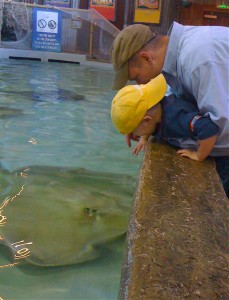Here are some excellent starting references to study the ocean! The links are to Amazon.com but many of these books haven’t been published in some time (oldies-but-goodies!) so you could check your local library.
Reference Books:
Early Man and the Ocean by Thor Heyerdahl. A wonderful book about the routes, vessels, and trading of early man, it has many drawings of early vessels of the past. Heyerdahl built the Kon-Tiki and the Ra and sailed them across the Atlantic and the Pacific Oceans. Heyerdahl does not make the assumption that early man was less intelligent than we are. On the contrary, he is a proponent of the theory that people traveled around the seas in very early times in vessels engineered for the purpose. Very interesting. Secondary students.
[amazon_link id=”B004TC14F0″ target=”_blank” ]The Sea Around Us[/amazon_link] by Rachel Carson. This classic book is full of study material about the seas and has lots of stories of the sea to illustrate her facts. My copy is a special edition for young readers which has plenty of pictures in it. The description of wave activity and power is especially intriguing. An excellent book to read to your young child or for solo reading for your older elementary student.
Mysteries & Marvels of Ocean Life by Rick Morris. This Usborne book is full of tidbits about the life forms in the seas.
Tide Poolsby Ronald Rood. Written for youngsters of 8-10, this book has an easy to read format with lots of descriptions of sea creatures to help the child form mental pictures of the organisms.
Sea Creatures Do Amazing Things by Arthur Myers. This Step-up Book is a great way to introduce the study of sea organisms. I can picture a homeschooler making cards for each animal and reporting on the animal to the rest of the family. This book has common organisms in it which are interesting and not frightening.7
Picture Books:
My Visit to the Aquarium (Trophy Picture Books) by Aliki. Well illustrated, this book reviews an imaginary trip to an aquarium. If your student has been to a real aquarium, this is an excellent way to remind your student of all the sights and wonders of the underwater world he saw during the trip. The few sentences have concise descriptions.
At Home in the Tide Pool by Alexandra Wright. This 12 year old author has written a picture book which tells what you might see in a tide pool. Oceanic vistas are not common to the people in inland United States, tide pools are even less frequently seen, so this book is not about a commonly seen habitat. Wright uses short sentences to describe a living environment concentrating on the activities of the organisms.
At Home in the Coral Reef by Dr. Katy Muzik. This picture book is similar to At Home at the Tide Pool in that organisms are described in their environments doing life activities. The fragility of the coral reef is emphasized.
Nature Hide and Seek: Oceans by John Norris Wood. This is a pleasant book which carefully illustrates some of the organisms of the sea hiding in their natural habitats. Five fold-out panoramas are included in the book. In between the panoramas are descriptions of some of the life forms inside the habitat on the previous page. Not all of the organisms pictured have been mentioned in the text. The format of the book is as a game wherein the student attempts to find all the hidden organisms.
Follow the Water from Brook to Ocean (Let’s-Read-and-Find-Out Science 2) by Arthur Dorros. This is a story in pictures of the water in a brook traveling down hill to the sea. At each step something is taught to the young student about water, perhaps that it responds to the pull of gravity or that it can carve out large canyons.
The Ocean Alphabet Book and The Underwater Alphabet Book. These books by Jerry Pallotta use the alphabet to introduce certain life forms and habitats of the seas to young readers. The books are light-hearted and do not over teach.
Games:
Krill – A Whale of a Game. In the Antarctic live a zooplankton called krill which are crustaceans like shrimp are which are eaten by whales. The food chain the two organisms belong to is the subject of this game. Students learn about this oceanic food web and about several concepts usually hard to understand. The upwelling of nutrient rich material from the ocean depths, the dependencies of higher orders of animals upon the plankton, and the loss of oceanic nutrients by human harvest are all made real by the events of this game.
Enjoy your study of the ocean and if you have other wonderful resources to share with us please leave a comment!



